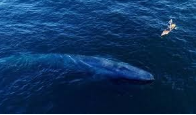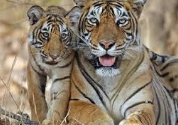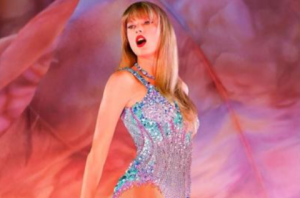10 Animals That Are Going Extinct

February 4, 2020
Animals are going extinct at a more rapid pace, and we need to pay attention to the animals that are most rapidly going extinct because of climate change, poaching, pollution, overfishing, and much more. It is important to have these animals because many ecosystems could collapse if they’re gone and generations to come would never get to see them.
- Blue Whale: 10,000-25,000 individual animals
The Blue Whale is the largest animal on the planet. It weighs as much as 200 tons – almost 33 elephants! A Blue Whale can reach a length of 80-100 feet and its heart is 1,300 pounds! A Blue Whale’s call can reach 188 decibels, making it the loudest animal call in the world! These gentle giants are disappearing, like other whales, because of climate change and toxins polluting their waters. Additionally, boat strikes can maim and kill the whales, along with fishing gear designed to suffocate and trap them. If you support the creation of whale sanctuaries, you can help protect them from fishing threats like commercial threats.
- The Black Rhino: More Than 5,500 Individual animals
The Black Rhino is the smallest of the 3 African Rhino species ranging from 4.3-5.9 feet tall and can weigh up to 3,080lbs. These animals usually have 2 horns but they can also grow a third smaller horn! In the mid-1900s, the Black Rhinoceros population fell 98% due to hunting and horn trafficking, which is when a poacher cuts off the horn of a rhino and sells it. Now, this species has bounced back from the verge of disappearing for good but is still critically endangered. To help this species you can donate to The Wildlife Society of South Africa that helps to stop illegal poaching of these rhinos.
- Galápagos Penguin: Fewer Than 5,000
The Galápagos Penguin is the only penguin of all 17 species that are located North of the equator in you guessed it… the Galápagos. These penguins, along with the other penguin species, are affected by water pollution, bycatch, and global warming. Cats, dogs and other species that were introduced to the penguins by humans are also threatening to the Galápagos Penguin giving them diseases or hunting them. Declines in their food such as mullet and sardines and unsuccessful breeding are other reasons for their decline. To help these birds, you can fundraise and donate the money to WWF that helps protect the Galápagos Penguin and other species around the world.
- The Sumatran Elephant: 2,400-2,800 Left
Over two-thirds of the Sumatran Elephant Inhabitat, the Broadleaf tropical forests in Sumatra, an island in Asia were destroyed due to deforestation. This killed many of these Elephants but poaching is their main problem. The male elephants are killed because of their ivory tusks, making the gender ratio unbalanced. This all made a major dent in the Sumatran Elephant’s population with nearly 70% of their species gone in just one generation. To help save these elephants you can donate to PTES that helps protect the Sumatran Elephant and other species.
- African Wild Dog: About 1,400 Adults Left
The African Wild Dog, also known as the African Painted Dog, is a beautifully patterned dog that lives in packs of ten or more. This dog can reach speeds up to 40 miles per hour in a sprint and weighs 40-70lbs. These animals are disappearing because of targeted and accidental killings by humans. Illnesses are rapidly spreading through packs, the competition between lions for food is difficult because they steal the Wild Dog’s food, and habitat loss is also threatening these Wild Dogs. To help these Painted dogs you can donate to AWF that help different African wildlife species.
different African wildlife species. - Sunda Tiger: Less than 400
Tigers are one of the most known big cats in the world, and it would be awful if they all went extinct. The Sunda Tiger lives the Island of Sumatra in rainforests, and has only about 400 of their species left, making them extremely rare. These tigers are threatened by being killed for commercial gain. According to a survey, poaching is the reason 80% of all the Sunda Tigers were killed, about 40 per year. Their habitat is also dying out, making the Sunda Tigers and other species die out. When livestock and people are in these tigers’ territory, the livestock becomes a meal and the humans have been injured or killed. Some of the villagers retaliate, making a big hate circle. To help save this tiger, you can donate to Rainforest Trust that helps save different species in the rainforests.
- Black-footed Ferret: Approximately 370 Left
This masked ferret is only weighing in at about 1.5-2.5 lbs! This little guy is one of the most endangered mammals in the world because of habitat loss. Their recovery is dependent on the grasslands of North America being restored. The ferret also needs prairie dogs because they use them by stealing their burrows and they eat prairie dogs for food. To revive the black-footed ferrets, you can donate to revive and restore that helps different animals come back from extinction.
- The Javan Rhino: 58- 68 Left
The Javan Rhino is the most threatened of all the rhino species with only about 60 left only in Ujung Kulon National Park in Java, Indonesia. These one-horned Rhinos used to be everywhere throughout India and Southwest Asia but the last one in that territory was shot in Vietnam in 2010. These animals are extremely vulnerable to extinction due to natural catastrophes, habitat loss, diseases, poaching, and potential inbreeding (family members breeding with one another, making their offspring deformed), making it hard to survive. To help save these Rhinos you can donate to the Rhino Conservation that protects Rhinos.

- Amur Leopard: More Than 84 Individuals
People usually think of the Savannas of Africa when they think Leopards, but this rare species has adapted to temperate rainforests! Temperate rainforests are rainforests that receive a lot of rainfall and occurs in a temperate climate. The Amur Leopards run at about 37 miles per hour like other leopards, and this big cat has been reported to be able to jump up to 19 feet horizontally and 10 feet vertically! These cats are poached for their spotted coat because of how valuable it is. These coats can be sold for up to $1,000 because of its beauty. This makes them highly wanted and threatens them greatly. Their prey species like the Roe Deer, Sika Deer, and many species of rodents are also being hunted for cash and food, making it hard to be an Amur Leopard. To help save the most endangered big cats in the world, donate to Wildlife Vets International that finds medicines that save wildlife globally.
- Vaquita: Only About 10 Individuals Left
The Vaquita is a water porpoise that needs help because it is the rarest marine mammal in the world! This species wasn’t discovered until 1958 and a little bit later was on the brink of extinction. These animals will be extinct if bycatch fishery is not eliminated in California or Mexico, where they live. Nearly one out of five Vaquitas get entangled and drown in gillnets. These nets were laid for another overfished animal called the Totoaba. Totoba is hunted for their bladders and used for traditional medicines in China. The more nets that are put in the ocean to hunt Totoaba the more Vaquitas die. You can sign a petition to help save this marine animal that is trying to change the Mexican government to protect these animals or you can adopt a stuffed animal vaquita from WWF or from the Porpoise Conservation Society.
In conclusion, these animals need our help badly. The more destroyed habitats, the more animals that are poached, and the higher climate rises all lead to humans. To help save these animals you can go to WWF (World Wildlife Fund) and adopt a stuffed animal, a certificate that goes towards saving their species or donate to any one of the causes to save a specific animal.
Works Cited
“Adopt a Vaquita.” Porpoise Conservation Society Giving, 29 Jan. 2020, give.porpoise.org/gift/adopt-a-vaquita/.
“African Wild Dog.” WWF, World Wildlife Fund, www.worldwildlife.org/species/african-wild-dog.
“Amur Leopard.” WWF, World Wildlife Fund, www.worldwildlife.org/species/amur-leopard.
“BLACK-FOOTED FERRET PROJECT.” Revive & Restore, reviverestore.org/projects/black-footed-ferret/.
“Black Rhino.” WWF, World Wildlife Fund, www.worldwildlife.org/species/black-rhino.
“Black-Footed Ferret.” WWF, World Wildlife Fund, www.worldwildlife.org/species/black-footed-ferret.
“Blue Whale.” WWF, World Wildlife Fund, www.worldwildlife.org/species/blue-whale.
Borochoff, Alexis. “15 Things You Can Do To Help Stop Rhino Poaching.” AFKTravel, 1 Mar. 2019, afktravel.com/81383/15-things-can-help-stop-rhino-poaching/.
Contributor. “How to Help Save Endangered Whales.” Sciencing, 17 Jan. 2020, sciencing.com/save-endangered-whales-2063162.html.
“Galápagos Penguin.” WWF, World Wildlife Fund, www.worldwildlife.org/species/galapagos-penguin.
“How to Help – Be the Voice for Those Who Have No Voice.” WWF, World Wildlife Fund, www.worldwildlife.org/how-to-help.
“Javan Rhino.” WWF, World Wildlife Fund, www.worldwildlife.org/species/javan-rhino.
“Javan Rhino Conservation Program.” International Rhino Foundation, 11 Dec. 2019, rhinos.org/where-we-work/javan-rhino-conservation-program/.
“Saving Sumatran Elephants in Indonesia- PTES Conservation Project.” People’s Trust for Endangered Species, ptes.org/grants/worldwide-projects/sumatran-elephants-in-indonesia/.
“Saving the Amur Leopard, the World’s Most Endangered Big Cat.” Saving the Amur Leopard, the World’s Most Endangered Big Cat, www.wildlifevetsinternational.org/projects/reintroduction-of-amur-leopard.
“Species List.” WWF, World Wildlife Fund, www.worldwildlife.org/species/directory?direction=desc&sort=extinction_status.
“Sumatran Elephant.” WWF, World Wildlife Fund, www.worldwildlife.org/species/sumatran-elephant.
“Sunda Tiger.” WWF, World Wildlife Fund, www.worldwildlife.org/species/sunda-tiger.
Trust, Rainforest. “The Last of the Sunda Tigers.” Rainforest Trust Saves Rainforest, Rainforest Trust Https://Www.rainforesttrust.org/Wp-Content/Uploads/RT-Horizontal-340pxW.Png, 7 Jan. 2020, www.rainforesttrust.org/last-sunda-tigers/.
“Vaquita.” WWF, World Wildlife Fund, www.worldwildlife.org/species/vaquita.
“Vaquita: What You Can Do to Help The Vaquita.” Porpoise Conservation Society, porpoise.org/knowledge-base/can-save-vaquita-porpoise/.
“A Look at the Endangered African Wild Dog.” African Wildlife Foundation, 1 July 2019, www.awf.org/wildlife-conservation/african-wild-dog.




